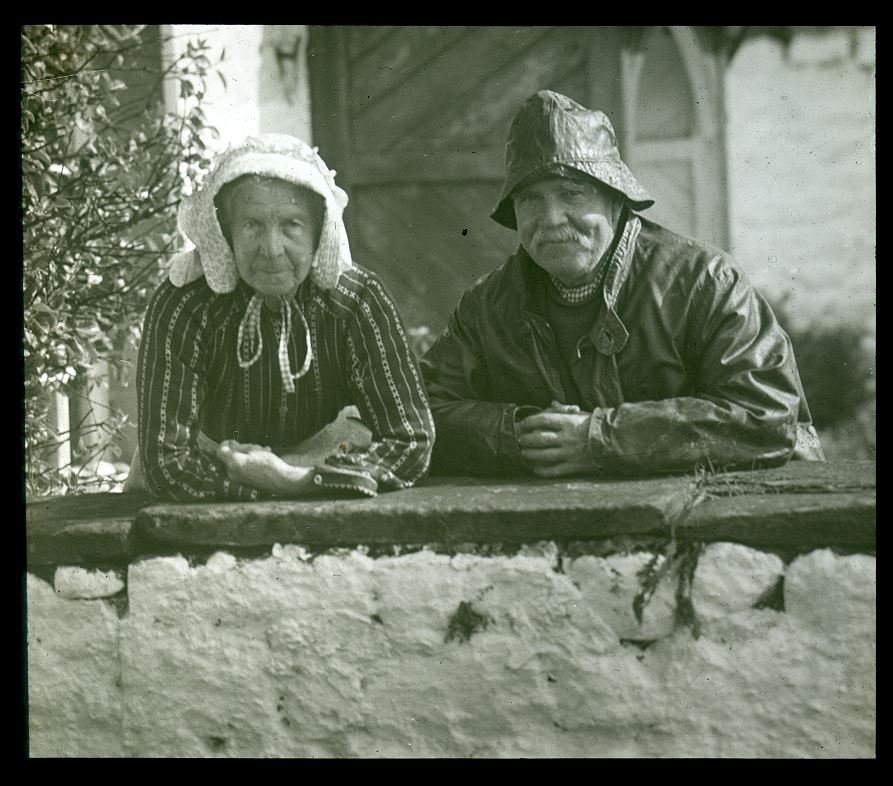Walker and Thompson Photographs
John Walker
Outside the Mission Church: A John Walker photograph 1894
This is the 1894 image which we used to see if we could track down the names of the villagers who appear in the photograph. We eventually recognised all the adults and some of the children. Follow this link to the article in the magazine.
We also wanted to know more about the photographer – John Walker.
We knew of him as his family had been researched by Beth Hampson for one of her books. John was a qualified solicitor but by mid-life he recorded in the census that he was non-practising. It seems he lived quietly with his mother and sisters on Aldcliffe Road in Lancaster. The family spent many of their summers at Sunderland Point living at Number 7. He never married and died in Lancaster aged 80 in 1939.
His father (also John Walker) was a well know Lancaster figure who for more than 30 years was Harbour Master of the Port of Lancaster as well as clerk to the Port Commissioners.
We discovered that for a number of years John had taken many photographs in and around the Point, also in Glasson Dock and at other locations. In 1906 he abruptly stopped, perhaps because his mother died in that year.
It quickly became important to locate more of his pictures. In Wilton Atkinson’s papers we found an article published in Lancashire Life in 1985. It described how his original plates, as many as 1100, had been discovered by a Lancaster bookseller at an auction sale. The finder subsequently offered them to the Lancaster City Museums for examination.
A copy of the 1985 John Walker article: With the permission of Lancashire Life
A selection of his photographs were used in the opening exhibition of the Maritime Museum. An earlier article in the Lancaster Guardian reported there were many photographs in the collection of Glasson Dock which were of great interest to the Maritime Museum in Greenwich, London.
Now very interested and intrigued we started looking for these plates. The trail quickly ran cold. We asked the Museums in Lancaster, the Maritime Museum, and the Lancashire Archives in Preston if they knew the whereabouts and drew a blank. We asked our friends and contacts for help, no success – at first. It was suggested that maybe they could be in Lancaster, at the Museum in Market Square. We got in contact with Rachel Roberts, the always helpful Collections Registrar. She promised to make a physical check.
With the help of colleagues, the plates were found (we had imagined them going down steps into deep and dusty cellars with torches searching among cobwebbed shelves).
Rachel explained to us that although they had been brought into the collection in the 1980s and 1990s, and carefully packed and catalogued, that catalogue had not been integrated into the wider records.
The collection has indeed been kept in good condition packed in special boxes and individually wrapped. Here is Rachel standing next to the collection holding one of the plates.
Rachel Roberts, Collections Registrar Lancaster City Museums: Photo by the author.
Hopefully, beginning soon, the plates will be digitalised by museum staff and sent to us in batches for identification where we can. We will help build a formal catalogue of the collection. From what can be seen there does appear to be a lot of Point photographs.
We have promised every assistance and in time, and with permission, we will display as many Sunderland Point photographs as possible on the website.
Sam Thompson
Ann Townley with her brother William Townley in a great Sam Thompson photo circa 1930s: From the Lancashire Archives
In our recent biographical article on Sam Thompson, we reported that most of his photographic plates were stored in the Lancashire Archives in Preston. We asked the Archives, on behalf of the community, if all the SP photographs could be transferred to us for presentation on the Website. We are delighted to say that for only nominal fee they have agreed to do just that.
We are permitted to show the photographs on the strict understanding that approval is for the website only and not for any other use without the express permission of the Archives.
A special gallery has been set up which can be accessed by following this link. Although many pf the photos are portraits of the same small group of fishermen, we decided for completeness to include every copy.
We would like to express our sincere thanks to Rachel Roberts and Lancaster City Museums, and to the Lancashire Archives. Both organisations could not have been more helpful.



